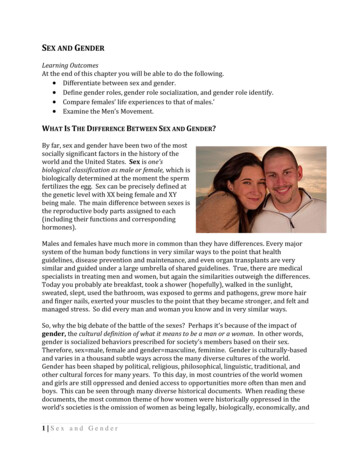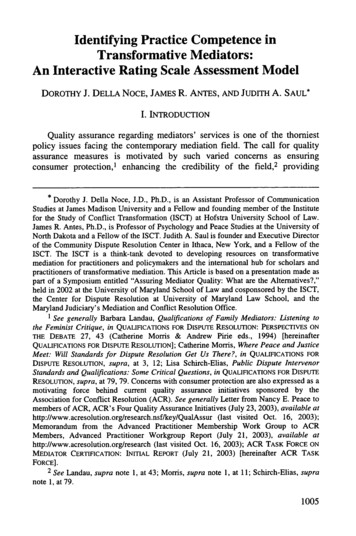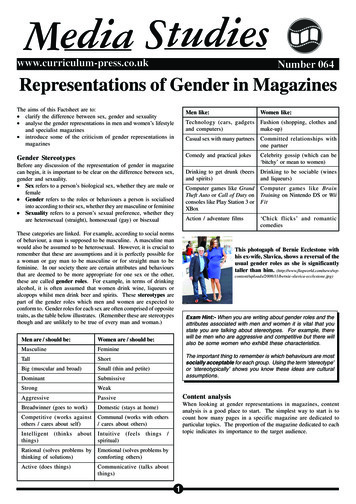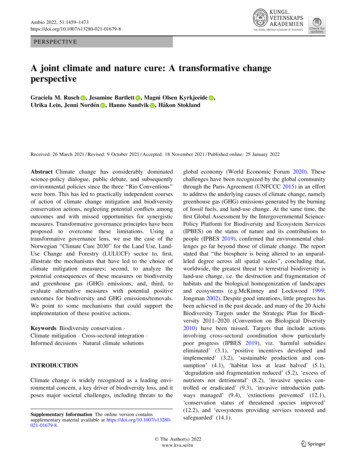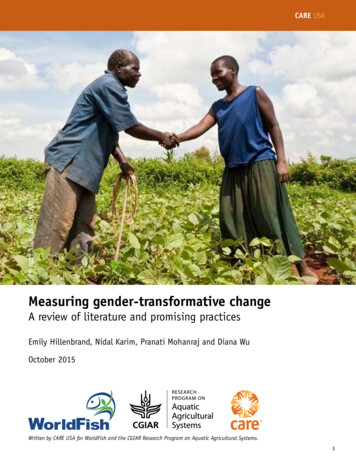
Transcription
2011 Sarah Elliott/CARECARE USAMeasuring gender-transformative changeA review of literature and promising practicesEmily Hillenbrand, Nidal Karim, Pranati Mohanraj and Diana WuOctober 2015Written by CARE USA for WorldFish and the CGIAR Research Program on Aquatic Agricultural Systems.1
ContentsAcknowledgments4Executive summary5What do we mean by gender-transformative change?5Gender-transformative measurement, evaluation and learning systems6Indicators of gender-transformative change7IntroductionMethodologyChapter 1: Measuring gender transformation1.1 Framework for understanding gender transformation1.1.1 Gender transformation, empowerment and social justice1.2 Measuring gender-transformative change88101010111.2.1 Gender-transformative measurement is multidisciplinary and multilevel111.2.2 Capturing the complex, relational and emergent nature of change121.2.3 Capturing diverse actors’ aspirations and experiences of change13Chapter 2: Monitoring, evaluation and learning systems that facilitate gender-transformative processes142.1 Monitoring staff and organizational gender equity and diversity awareness and practice152.2 Social and gender analysis2.2.1 Measuring local aspirations for gender-transformative change172.2.2 Exploring gender-based violence172.2.3 Exploring social norms182.3 Gender-transformative theories of change developed through participatory methods192.4 Monitoring outcomes202.5 Critical reflection with a gender lens212.6 Focus on and resources for participatory monitoring, evaluation and learning capacity building22Chapter 3: Indicators of gender-transformative change3.1. Power over: Control over income, assets and resources23233.1.1 Income generation and labor233.1.2 Control over assets273.1.3 Control over land293.2 Power over: Control over others303.2.1 Mobility303.2.2 Gender-based violence323.2.3 Control over the agenda333.3 Power to3.3.1 Knowledge and skills2153535
3.3.2 Awareness and conscientization353.3.3 Nutrition and health outcomes353.3.4 Bodily integrity363.4 Power within: Internal and psychological resources383.5 Power with403.5.1 Collective action and group strength413.5.2 Social capital, networks and solidarity433.5.3 Equitable household decision-making43Chapter 4: Recommendations47Notes51References523
AuthorsEmily Hillenbrand; Pranati Mohanraj, PhD; Nidal Karim, PhD; and Diana WuCitationThis publication should be cited as: Hillenbrand E, Karim N, Mohanraj P and Wu D. 2015. Measuring gendertransformative change: A review of literature and promising practices. CARE USA. Working Paper.AcknowledgmentsThis working paper was initiated by Dr. Paula Kantor, whose passionate commitment to gender equality, transformativechange, and rigorous and thoughtful scholarship continues to inspire. Dr. Maureen Miruka, Pathways Team Leader atCARE, and Theresa Hwang, Gender Director at CARE USA, encouraged the partnership and created time for this paperto take shape. Miranda Morgan and Dr. Cynthia McDougall provided valuable feedback and guidance in shepherding thepaper to completion.In typical style, Paula received the first draft of this report on December 15 and returned it the following morning withgracious appreciation and thorough, thoughtful and pointed comments on how to restructure and focus the report.In particular, she stressed that we should focus on CGIAR Research Program on Aquatic Agricultural Systems (AAS)frameworks and CARE’s practical work and that we should be concise, so that others would be more likely to read anduse the document. We hope that through this work and the ongoing collaboration between CARE and WorldFish, we carryon her legacy of promoting transformative change in the lives and livelihoods of fishers and farmers.Funding for this initiative was generously provided by AAS.4
Executive summaryWhat do we mean by gender-transformative change?Gender-transformative approaches aim to move beyond individual self-improvement among women and towardtransforming the power dynamics and structures that serve to reinforce gendered inequalities. As defined by the CGIARResearch Program on Aquatic Agricultural Systems (AAS), a gender-transformative approach to development goes beyondthe “symptoms” of gender inequality to address “the social norms, attitudes, behaviors, and social systems that underliethem” (AAS 2012, 3). This approach entails engaging groups in critically examining, challenging and questioninggender norms and power relations (Rottach et al. 2009) that underlie visible gender gaps. Transformative change can bemeasured by examining three broad domains of empowerment: agency: individual and collective capacities (knowledge and skills), attitudes, critical reflection, assets, actions, andaccess to services relations: the expectations and cooperative or negotiation dynamics embedded within relationships between peoplein the home, market, community, and groups and organizations structures: the informal and formal institutional rules that govern collective, individual and institutional practices,such as environment, social norms, recognition and status (Martinez and Wu 2009; Morgan 2014).Considering all three of these dimensions helps reframe the discourse of empowerment—and the burden of change—from a focus on women’s individual agency to collective responsibility and political engagement and action.Kabeer (2005, 22) critiques the dominant development discourse (in the form of the Millennium Development Goals)for reducing the framing of the process of empowerment to a “series of technical goals to be implemented mainly bythe very actors and institutions that have blocked their realisation in the past.” Others have echoed this concern, andspecifically t hat mainstream gender approaches promote an instrumental view of empowerment, focusing on individualwomen as a force for catalyzing development outcomes and efficiencies. These approaches speak in terms of “unleashingthe potential” of women as drivers of economic growth, as superior investors in savings, health and education, etc.(Razavi and Miller 1995; Cornwall 2014). This approach reflects neoliberal economic development models and avoidsexamination of how large -scale development policies may interact with existing power relations and social norms tohinder social justice and women’s autonomy (Chant and Sweetman 2012; Razavi 2012).This mainstream framing edits out the political processes of grassroots mobilization of women and sidelines thefeminist values of building women’s awareness and capacities to challenge patriarchal structures and relations on theirown terms. Gender-transformative approaches to development, in contrast, hold a conceptualization of empowermentthat embraces its feminist roots. Gender-transformative change and processes of empowerment are ultimately abouttransforming unequal power relations and the structures and norms (both visible and invisible) that uphold them.Within this framing, understanding and measuring changes in empowerment entails an examination of the multiplemanifestations of power and how they interact to create unequal outcomes. In this paper, we refer to four dimensions ofpower. Power over—defined as control over people, resources and others’ lives—is the most commonly addressed formof power. Power to act and to realize one’s aspirations is directly related to the agency dimension of empowerment andis frequently measured in terms of individual skills, capacities and self-confidence. Power within refers to a person’sor group’s sense of self-worth, self- awareness, self-knowledge and aspirations, which are also related to agency andshaped by social norms and gendered institutions. Power with involves collaborative and collective power with othersthrough mutual support, collaboration, recognition and respect for differences. This can take place at multiple levels,from household and intimate relationships to cooperatives and collectives, as well as broader-level coalitions andmovements for change.5
Gender-transformative measurement, evaluation and learning systemsGender-transformative change questions internalized belief systems and closely held identities, challenges entrenchedinstitutionalized structures, and deals with everyday habits and relationships that may be caring as well as unequal.Such change is often emergent rather than linear; it is multidimensional and sensitive to diverse actors’ experiences ofchange (Kantor and Apgar 2013). Chapter 2 describes how measuring such change is an inherently complex and holisticendeavor and explains that gender-transformative measurement systems must be equipped to embrace complexityand context- specificity, as well as the halting and often unpredictable nature of social change. Applying a feministevaluation lens to gender-transformative measurement systems can provide epistemological guidelines for embracingcomplexity and capturing the critical intersections of gender, race, class and sexuality in the power dimensions ofagency, relations and structures (Mertens 2005). Feminist evaluation is not prescriptive but rather offers a lens andframework for thinking about evaluation and unpacking the deeper systems and beliefs beneath surface-level differencesin gender roles, relations and outcomes. It also acknowledges that the process of evaluation itself can reinforce orchallenge power relations —there are different ways of knowing, and power relations and social norms may privilege theperspectives of certain actors over marginalized others (McRobbie 1982; Hirsch and Keller 1990; Beardsley and HughesMiller 2002; Hughes 2002; Podems 2010). Thus, the systems used for monitoring, evaluating and learning about gendertransformative change are as important as the indicators themselves.The literature on measuring gender-transformative change indicates that adopting gender-transformative approachesand measurement systems begins with critical examination of an institution’s practices, which helps an institution toidentify how its own research practices can contribute to (or are currently impeding) empowerment and broader socialchange processes. Creating structured spaces and processes for critically examining beliefs, attitudes and practicesaround gender among staff and partners enables gender-transformative approaches and measurement systems by helpingresearch and development institutions identify their roles as key actors and power holders in the social systems theystudy (Batliwala and Pittman 2010; Derbyshire et al. 2015).Robust and accurate theories of change help make explicit fundamental assumptions about why a program should workand help programs identify pertinent indicators. Applying a feminist lens, bringing in explicit gender expertise anddiverse stakeholder views, and conducting social and gender analysis can ensure that such theories of change addressunderlying social structures, policies and broadly held social norms that perpetuate gender inequalities (Hirsch andKeller 1990; Beardsley and Hughes Miller 2002; Hughes 2002; McRobbie 1982 in Podems 2010).Privileging qualitative and participatory techniques alongside quantitative indicators is a common feature of gender transformative change measurement. Qualitative approaches can be used to develop quantitative indicators of changethat are robust, contextually meaningful and comparable across diverse program regions (Bragin et al. 2014; CARE2015). Research processes that privilege marginalized perspectives, validate different ways of knowing and promotecritical examination of gender norms can themselves be transformative, contributing to social transformation andbuilding the skills “to question, analyse, and act on the structures of patriarchal constraint in their lives” (Kabeer 2005,15).Recognizing that the kinds of changes that gender-transformative approaches aim for are ambitious, context-specific,typically take a long time and rarely progress in a linear fashion, a responsive monitoring, evaluation and learningsystem may also require a perspective shift in terms of what “success” looks like. The selection of gender-transformativemeasurement processes requires tools and approaches, such as progress markers and outcome mapping, that assesschange as an incremental process instead of an endpoint and final product (Guijt 2008).Finally, many monitoring, evaluation and learning systems are inadequate in tracking risk, negative change, backlashand unanticipated change. Given the unpredictable nature of social change, gender-transformative monitoring,evaluation and learning systems require robust tools and systematic processes for risk monitoring as well as genderexpertise for interpreting the pushback that often accompanies progress in women’s rights work (Batliwala and Pittman2010). Participatory learning processes such as systematization unpack how different stakeholders experienced aninitiative’s evolution and help situate how strategies and adaptations interacted in real societies beyond what wasenvisioned in initial proposals and planning (Phartiyal 2006; Tapella and Rodriguez-Bilella 2014). Such approachesfacilitate a more active response to emerging challenges and are a mechanism for ensuring researchers’ accountability inthe complex and critical endeavor of promoting more equitable and just smallholder systems.6
Indicators of gender-transformative changeGender-equitable transformation grows more cooperative forms of power and relationships (power with) that affirmdiverse people’s critical awareness and dignity (power within) and their capabilities and aspirations (power to; Freire1970; Hooks 2004; Miller et al. 2006). Chapter 3 of this report examines existing indicators of gender-transformativechange in agriculture and aquaculture systems from the lens of these four critical dimensions of power, and across thedomains of agency, relations and structures. While there are many rigorously tested indicators of the first two dimensionsof power (capacities and access to resources) from the individual agency level, this framing elevates the focus fromindividual to systems-level change. The indicator review demonstrates that while there are fewer standardized indicatorsfor the other dimensions of power, there is a wealth of promising processes and practices for measuring meaningfulrelational change, social norm change or change in the less tangible aspects of recognition. Examining indicators ofpower within and power with brings back into focus feminist theory and its understanding of gender equality as apolitical project, drawing renewed attention to the importance of consciousness-raising and women’s collective action asindispensable ingredients of sustainable, meaningful social change (Cornwall 2014). 2014 Evan Pantiel/CARE7
IntroductionThe development impacts of gender inequality are well documented. Where women generally have greater access toeducation, work and income, communities see positive household impacts in relation to health and mortality (Kabeerand Natali 2013). Societies characterized by the denial of women’s rights (in terms of access to resources, decision-making, status and gender-based violence) also tend to be more prone to violent conflict (Schmeidl and Piza-Lopez2002). Further, deep gender discrimination and gender-based violence are generally associated with lower laborproductivity, poorer educational outcomes, lower child health and nutrition and higher child mortality rates, strainson social and health service systems, an d poorer overall economic growth from household to community and nationallevels (Morrison and Orlando 2004; Kabeer and Natali 2013; Joint Irish Consortium on Gender Based Violence n.d.).Studies have shown that greater gender equality supports greater and more sustainable development. However, theconverse relationship—that economic development automatically promotes gender equality—does not hold true (Kabeerand Natali 2013). As such, measurement of development program processes and outcomes must pay particular attentionto both how different genders are affected by development programming and how interventions are supporting women’srights and gender equality (UN Women 2013).In the agriculture and aquaculture sectors, mainstream discourse acknowledges the importance of smallholder agricultureand aquaculture for economic growth and climate resilience, as well as the central importance of women smallholders tosuch development strategies. However, there is growing recognition that the decades of focus on rural women’s economicempowerment have failed to bring about significant structural improvements in these critical livelihood sectors (Morgan2014). Mainstream approaches to women’s economic empowerment have been critiqued as technical fixes and a matterof filling gaps in access to resources that fail to acknowledge that social, political and market systems are not neutral,but structured in a way that reflect and reinforce the societal inequalities that shaped them (Razavi and Miller 1995;Kabeer 2005; Cornwall 2014). Without directly confronting and acknowledging the issues of power and social justice—that is, transforming the political, social and structural dimensions of gender inequality—gender injustice will continueto exacerbate poverty and hinder social development (Kabeer and Natali 2013; UN Women 2013; Cavalcanti and TavaresJ. 2016).Recognizing that the impact we hope for in development practice will not happen through business as usual, WorldFishand CARE are deliberately committed to bringing about more equitable social transformation through their gendertransformative approaches to agriculture research and development practice in agriculture and aquaculture (Morgan2014). Through AAS and CARE’s integrated agriculture platform, both organizations have and are actively pioneering,testing and sharing new frameworks and processes for promoting gender-transformative change and outcomes, with afocus on underlying social norms, gender relations in market systems and long-term societal change.MethodologyNew ways of working require a broader understanding of the outcomes and impact we are seeking and new ways ofmeasuring and learning from our work. This report broadly examines existing literature on frameworks and monitoring,evaluation and learning systems, as well as specific indicators and approaches for measuring gender-transformativechange, particularly in the smallholder agriculture sector. The literature review was commissioned by AAS and isintended to inform WorldFish and CARE initiatives and monitoring and evaluation practices going forward. It wasconducted over a period from October to December 2014 by a team of gender specialists from CARE USA, a developmentorganization whose livelihoods approaches and empowerment frameworks share gender-transformative aims andapproaches similar to those of AAS. The literature review began with an examination of the AAS monitoring, evaluationand learning system, its approach to gender-transformative programming, and its publications to date on gendertransformative change, including an internal review of the literature on gender-transformative approaches conductedas part of the program. The initial working definition of “gender-transformative approaches” was drawn from CARE andWorldFish institutional frameworks, which are similar in scope and approach and are aligned to feminist writings onempowerment and development, including the ongoing work of Naila Kabeer, Srilatha Batliwala and the research programPathways of Women’s Empowerment, established as a consortium of feminist research centers in Latin America, theMiddle East, South Asia, West Africa and the United Kingdom. The authors scanned the existing literature to compile aninitial document list of writings on gender -transformative measurement and indicators, using key word searches with8
terms such as “gender-transformative,” “women’s empowerment,” “social norms” and “gender equity.” With an explicitfocus on relevant experience within the aquatic agriculture and livelihoods sector, the literature review also collectedpublished and unpublished program documents from CARE, AAS, and other organizations with gender-focused livelihoodsand agriculture programs. The review of gender-transformative indicators and approaches draws liberally from theseexamples.A Microsoft Excel matrix was used to organize these documents (a total of 60) into several categories:1) feminist critiques of development, including conceptual writing on women’s empowerment and how the concepthas evolved within the mainstream development industry;2) guidance documents related to specific gender-transformative approaches to measuring change;3) discussions and critiques of specific livelihoods indicators;4) documents with multidimensional gender-transformative indices of poverty or empowerment, including theWellbeing Index developed by the University of Bath, the Individual Deprivation Measure, the Organisation forEconomic Co-operation and Development’s Social Institutions and Gender Index, and the Women’s Empowermentin Agriculture Index (WEAI).The analysis followed an iterative process among the authors of summarizing the divergent and similar findings amongthe readings, selecting the pertinent indicators for the livelihoods and aquatic agriculture sector, and synthesizing thefindings. The report is organized into three sections: a framework for understanding gender-transformative change; adiscussion on the key features of gender-transformative measurement, evaluation and learning systems; and a criticalevaluation of potentially gender-transformative indicators currently being used in the livelihoodssector. Throughout,1the analysis focuses on two key aspects of social injustice—patriarchy and heteronormativity —as the deep-rootedbelief systems that underlie gender injustice and permeate the key structures and relations in the systems in question.This review highlights promising practices as well as existing gaps in gender-transformative measures and offers aset of recommendations for development practitioners and researchers on identifying leading indicators for gendertransformation and how to integrate gender - transformative measures into programming.1According to Wikipedia, “Heteronormativity is the belief that people fall into distinct and complementary genders (man and woman) with naturalroles in life. It assumes that heterosexuality is the only sexual orientation or only norm, and states that sexual and marital relations are most (oronly) fitting between people of opposite sexes. Consequently, a ‘heteronormative’ view is one that involves alignment of biological sex, sexuality,gender identity and gender roles. Heteronormativity is often linked to heterosexism and homophobia.[1]” Accessed 24 May 2016. https://en.wikipedia.org/wiki/Heteronormativity.9
Chapter 1: Measuring gender transformation1.1 Framework for understandinggender transformationThe Interagency Gender Working Group (IGWG) says thefollowing: “Gender-transformative approaches activelystrive to examine, question, and change rigid gendernorms and imbalance of power Gender-transformativeapproaches encourage critical awareness among men andwomen of gender roles and norms; promote the positionof women; challenge the distribution of resources andallocation of duties between men and women; and/or address the power relationships between women andothers in the community” (Rottach et al. 2009, 8). Theseapproaches aim to go beyond individual self-improvementamong women toward transforming power dynamics andstructures that act to reinforce gendered inequalities.1.1.1 Gender transformation,empowerment and social justiceGender-transformative change, framed as moving towardgender equality, can be examined across three keydimensions (Martinez and Wu 2009; Morgan 2014): agency: individual or collective capacities (knowledgeand skills), attitudes, critical reflection, assets,actions, and access to services; relational (intrahousehold and beyond): theexpectations and cooperative or negotiation dynamicsembedded within relationships between peoplein the home, market, community, and groups andorganizations; structural: informal and formal institutional rulesand practices (environment, norms, recognition andstatus).These three domains offer a broad framework for understanding where transformation is needed to advancegender equality. Each is deeply interconnected with theothers. Individuals’ aspirations and attitudes are largelyinfluenced by the social norms and practices within theirsocieties, as well as the quality of their relationshipsand support networks. Evidence has also shown thatprogramming focused on one domain risks reversibilityand harm if it fails to engage the other domains forgender-transformative change (Martinez 2006; World Bank2012).Women’s empowerment is often framed by developmentindustry actors (donors, international nongovernmentalorganizations [NGOs] and governments) as “unleashingthe potential” of women to drive economic growth10in terms that are more market oriented than gendertransformative. Over the past two decades, developmentactors have redefined the term by focusing more onindividual improvement than social change and framingempowerment as a means for development efficiency,often tied to neoliberal models (Razavi and Miller 1995;Cornwall 2014). This has shifted gender-transformativechange in development to a technical issue aimed atincorporating women into existing market (or other)systems rather than apolitical one that mayquestion how systemsWe have to talkare established andabout liberatingfunction to perpetuateminds as well asinequality, exploitationliberating societyand exclusion. As aresult, this perspective- Angela Davistends to ignore howmacroeconomicpolicies and large-scaledevelopment initiatives affect women’s autonomy (e.g. inrelation to land ownership, local seed system autonomy,and women in agriculture technical programming),interact with existing power relations and social norms,and disrupt local agricultural systems (Razavi 2012).To reinforce the transformative nature of change, it isuseful to emphasize how gender transformation relates topower and social justice. Gender-transformative changerequires individual agency through critical analysis andawareness of how power inequalities affect relationshipsand opportunities, network-building to strengthenrelationships (in homes and beyond), and organizing toinfluence structural change (Miller et al. 2006; WorldBank 2012). This change is ultimately about transformingpower relations, which can be understood by recognizingdifferent forms of power: Power over is used to privilege certain people overothers. The most commonly discussed form of power,power over involves denying certain groups accessto important resources (e.g. land) and services (e.g.healthcare and jobs), as well as control over others’lives (e.g. mobility and political domination). In theabsence of alternative forms of relating to one anotherand more affirming relationships (Miller et al. 2006). Itis directly linked with Fraser’s (1996) framing of socialjustice:1) redistribution : distribution of power, resources,opportunities and assets (power over resources);2) recognition : value given to different groups andtheir noneconomic or holistic aspects to well-being,as well as to household, market, reproductive and
productive activities and measures (power overideology). Power to involves the potential of a person or groupto form, pursue and realize aspirations for theirlife and society. This can include education, skills,capabilities and the confidence to exercise them. Thisdirectly ties to the agency domain of change (Miller etal. 2006). Power within refers to a person or group identity’ssense of self-worth, self-awareness, self-knowledge andaspirations, which are also related to agency (Miller etal. 2006). Power with involves collaborative and collective powerwith others through mutual support, collaboration,recognition and respect for differences. This can takeplace at multiple levels, from household and intimaterelationships to cooperatives and collectives, as wellas broader-level coalitions and movements for change.This offers a normative alternative for structuraltransformation, upheld through more equitable andaffirming gender relations (Miller et al. 2006).Pursuing gender justice focuses on transformingoppressive systems of heteronormativity and patriarchythat shape societies (power over). However, it isimportant to acknowledge that pursuing structuralchange and social justice that expand the freedomsof one group does not necessitate diminishing thefreedoms of another. The work of gender-transformativechange is not to simply reverse systems of hierarchy andoppression but to seek liberation from them. Genderequitable transformation grows more cooperative forms ofpower and relationships (power with) that affirm diversepeople’s critical awareness and dignity (power within)and their capabilities and aspirations (power to; Freire1970; Hooks 2004; Miller et al. 2006). Indicators ofthese four dimensions of power are discussed in greaterdetail in Chapter 3 of this report. CARE’s online GenderToolkit also provides further discussion on analyzing andunderstanding relationships of power.1.2.1 Gender-transformativemeasurement is multidisciplinary andmultilevelOperating in the real world, interventions engage withdynamic (not static) societies, which are affected byother institutions (e.g. media, economic trends andopportunities) and a host of other factors. Experience hasalso shown that progressive shifts toward greater genderequity in one area of life (e.g. women are increasinglyrepresented in the workforce) may be accompanied bysetbacks in another (e.g. rising rates of gender-basedviolence; Martinez 2006). The multiple factors and actorsat play suggest the need for measurement of gendertransformative change to take a systems approach(Narayan 2005). Rao and Kell
Gender-transformative measurement, evaluation and learning systems Gender-transformative change questions internalized belief systems and closely held identities, challenges entrenched institutionalized structures, and deals with everyday habits




